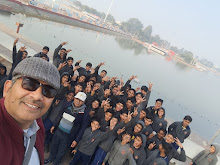PM SHRI KV OCF Sector 29 Chandigarh
A Creative Workshop Space for Classes VI–XII
Location: ................
Dimensions: 6/8 ft (width) × 40 ft (length)
Objectives
Introduce students to vocational skills: carpentry, plumbing, painting, electrical work, potting, etc.
Foster creativity, problem-solving, and practical knowledge.
Promote the reuse of school/home waste for tool displays and workshop materials.
Encourage experiential learning aligned with NEP 2020.
Skill Stations
Skill Activities - Carpentry
- Sawing, assembling, measuring
- Plumbing
- Pipe fittings, leak repair
- Painting
- Brushwork, stencils, wall art
- Electrical
- Wiring, switches, circuits
- Pottering
- Mud Clay pots
Waste Utilization Ideas
Old pipes → plumbing demos
Broken furniture → carpentry practice
Discarded wires → electrical mock-ups
Used paint cans → storage or decoration
Scrap wood/metal → tool holders, signage
Student Engagement
Weekly hands-on sessions by class groups
Peer-led mini-projects and competitions
Guest demos by local artisans and parents
Display of student creations during exhibitions
DIY challenges and exhibitions
Visual Appeal
Color-coded zones for each skill
Inspirational quotes and safety tips on walls
Student-made posters and charts
Recycled decor elements (tyres, bottles, pallets)
Safety & Supervision- TGT WE/ AE/...........volunteer under Vidyanjali
Adult supervision during tool use
Safety gear mandatory for machines
Clear instructions and emergency protocols
Expected Outcomes
Enhanced practical understanding and confidence
Early exposure to vocational career paths
Improved teamwork and creativity
Stronger school-community collaboration
Section Description - Wall Display Zone
- Pegboards or recycled panels showcasing tools (hammers, wrenches, brushes, testers, etc.) with labels.
- Work Tables
- Sturdy tables (made from reused wood/metal) for hands-on activities and machine placement.
- Storage Units
- Upcycled cabinets or crates for tool safety and organization.
- Creative Corner
- Student-made models, posters, and DIY innovations using scrap materials.
- Safety Zone
- First-aid kit, gloves, goggles, and safety instructions prominently displayed.
Call to Action
Invite support from staff, parents, and the community
Encourage donations of tools or materials
Propose a launch date and student involvement
Class-Wise Vocational Activities Inspired by NCERT Books
Class VI–VII: Foundation & Familiarization
- Tool Talk: Identify and name common tools (carpentry, plumbing, painting)
- Safety First: Create posters on tool safety and hygiene
- Waste Wonders: Make pencil holders or organizers from scrap
- Mini Models: Build simple cardboard furniture or pipe layouts
- Color Play: Practice brush strokes and color mixing on paper
Class VIII: Kaushal Bodh Integration
- Hands-On Modules from Kaushal Bodh:
- Carpentry: Measuring, sawing, assembling a small stool
- Plumbing: Pipe joint demo using old pipes
- Electrical: Simple bulb circuit with switch
- Painting: Wall art or stencil work on chart paper
- Creative Recycling: Make tool holders from waste wood or cans
- Skill Journal: Maintain a logbook of learned skills and reflections
Class IX–X: Skill Application & Innovation
- Mini Projects:
- Build a birdhouse or toolbox (carpentry)
- Create a water-saving model (plumbing)
- Wire a mock switchboard (electrical)
- Peer Teaching: Students explain tool use to juniors
- Design Thinking: Solve a real-life problem using vocational skills
- Exhibition Prep: Display models, posters, and working demos
Class XI–XII: Career Exploration & Mastery
- Advanced Projects:
- Furniture repair or upcycling
- Leak detection and repair simulation
- Paint a classroom wall or mural
- Assemble a working electrical board
- Entrepreneurial Pitch: Present a business idea using learned skills
- Internship/Guest Demo: Invite local artisans or visit workshops
- Portfolio Creation: Document projects, photos, and reflections
Features
- Hands-on activities and illustrations
- Aligned with NEP’s experiential learning goals
- Encourages creativity, observation, and analysis
- Suitable for students aged 12–21
- Portable and classroom-friendly format


































